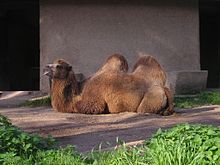| Bioparco di Roma | |
|---|---|
 | |
|
| |
| 41°55′03″N 12°29′07″E / 41.91750°N 12.48528°E | |
| Date opened | 5 January 1911 [1] |
| Location | Rome, Italy |
| Land area | 17 ha (42 acres) [2] |
| No. of animals | 1114 |
| No. of species | 222 |
| Annual visitors | 780,057 (2008) [3] |
| Memberships | EAZA, [4] WAZA [5] |
|
| |
Bioparco di Roma is a 17-hectare (42-acre) zoological garden located on part of the original Villa Borghese estate in Rome, Italy. There are 1,114 animals of 222 species maintained.
History
The zoo was conceived in 1908 to hold exotic animal species for exhibition. Unlike other zoos at the time which mainly worked for scientific criteria, this zoo was designed for the entertainment and amusement of the people. The zoo covered 12 hectares (30 acres) and was erected in the northern part of the Villa Borghese estate; it was opened on 5 January 1911.

The zoo was designed by Carl Hagenbeck, who had already opened a zoo in Hamburg Stellingen. The park was built in the style of that in Hamburg: ditches and pits instead of bars, and generous green spaces. [2]
This initial success did not hold. Attempts were made to stock the zoo with especially rare and exotic animals. Various park expansions were undertaken and in 1926 a further expansion was planned into the neighboring red deer park. In 1933, the architect Raffaele De Vico began his work in the new areas, which were to hold two main attractions: the large aviary and the reptile house which opened in 1935.
The zoo began to deteriorate, although many areas were renovated and others fully rebuilt. In 1970, the reptile house had to be closed due to its ailing condition; its improvements took about nine years and it was finally re-opened in 1983.
The idea to transform the zoo into a biopark was first suggested in 1994. In 1997, a master plan was produced based on the principles of the Gilman Foundation. In April 1998, the organization Bioparco S.p.A. was established to be financed through the city of Rome with 51%, from Costa Edutainment with 39%, and from Cecchi Gori with 10%.
Animals
As of 2022: [6]
List of animals
- Mammals
- Red-necked wallaby
- Big hairy armadillo
- Capybara
- Patagonian mara
- Asian small-clawed otter
- Binturong
- Meerkat
- Eurasian lynx
- Persian leopard
- Sumatran tiger
- Asiatic lion
- Eurasian wolf
- African wild dog
- Fennec fox
- Maned wolf
- Brown bear
- California sea lion
- Grey seal
- Ring-tailed lemur
- Black lemur
- Red ruffed lemur
- Pygmy marmoset
- Cotton-top tamarin
- Emperor tamarin
- Tufted capuchin
- White-collared mangabey
- Japanese macaque
- Mandrill
- Lar gibbon
- Chimpanzee
- Orangutan
- Asian elephant
- South American tapir
- Southern white rhinoceros
- Turkmenian kulan
- Grévy's zebra
- Hippopotamus
- Pygmy hippopotamus
- Red river hog
- Bactrian camel
- Guanaco
- Vicuña
- Reticulated giraffe
- Banteng
- European bison
- European mouflon
- Wild goat
- Himalayan tahr
- Nile lechwe
- Addax
- Dama gazelle
- Birds
- Common ostrich
- Emu
- Southern cassowary
- Greater rhea
- Crested guineafowl
- Indian peafowl
- Common shelduck
- Ruddy shelduck
- Cape Barren goose
- Pied avocet
- African penguin
- Great white pelican
- Eurasian spoonbill
- Roseate spoonbill
- African sacred ibis
- Northern bald ibis
- Scarlet ibis
- Cattle egret
- Marabou stork
- White stork
- Greater flamingo
- Grey crowned crane
- Salmon-crested cockatoo
- Blue-and-gold macaw
- Red-fronted macaw
- Abyssinian ground hornbill
- Golden eagle
- Mountain caracara
- Egyptian vulture
- Rüppell's vulture
- White-backed vulture
- King vulture
- Tawny owl
- Eurasian eagle-owl
- Snowy owl
- Reptiles
- Aldabra giant tortoise
- Alligator snapping turtle
- Elongated tortoise
- Giant musk turtle
- Kleinmann's tortoise
- Malayan box turtle
- Pancake tortoise
- Radiated tortoise
- Red-footed tortoise
- Spider tortoise
- Vietnamese pond turtle
- Smooth-fronted caiman
- Dwarf crocodile
- Nile crocodile
- Komodo dragon
- Blue-tongued skink
- Gila monster
- Philippine sailfin lizard
- Spiny-tailed monitor
- Standing's day gecko
- Common agama
- Rough-scaled lizard
- Cuban rock iguana
- Madagascan collared iguana
- Utila spiny-tailed iguana
- Ornate uromastyx
- Boa constrictor
- Green anaconda
- Yellow anaconda
- Madagascar tree boa
- Pacific ground boa
- Carpet python
- Central African rock python
- Sumatran short-tailed python
- Horned viper
Gallery
-
Pygmy hippopotamus at Fondazione Bioparco di Roma on zooinstitutes.com
Notes
- ^ "History". giardinozoologicodiroma.it. Giardino Zoologico di Roma. Retrieved 18 September 2011.
- ^ a b "1911-2011: 100 years of history". bioparco.it. Bioparco Di Roma. Archived from the original on 25 April 2012. Retrieved 11 November 2011.
- ^ "I dossier del Touring Club Italiano: 2009" (PDF). touring.it. Touring Club Italiano. p. 4. Archived from the original (PDF) on 18 April 2012. Retrieved 11 November 2011.
- ^ "EAZA Member Zoos & Aquariums". eaza.net. EAZA. Retrieved 18 September 2011.
- ^ "Zoos and Aquariums of the World". waza.org. WAZA. Retrieved 18 September 2011.
- ^ "Gli Animali do Bioparco". bioparco.
External links
- Official website
- Bioparco di Roma on zooinstitutes.com
-
 Bioparco di Roma travel guide from Wikivoyage
Bioparco di Roma travel guide from Wikivoyage -
 Media related to
Bioparco di Roma at Wikimedia Commons
Media related to
Bioparco di Roma at Wikimedia Commons
| Preceded by Via Veneto |
Landmarks of Rome Bioparco di Roma |
Succeeded by Villa Ada |







